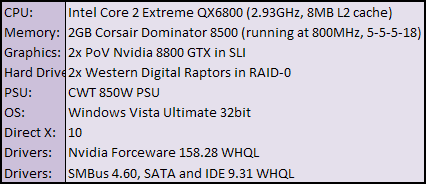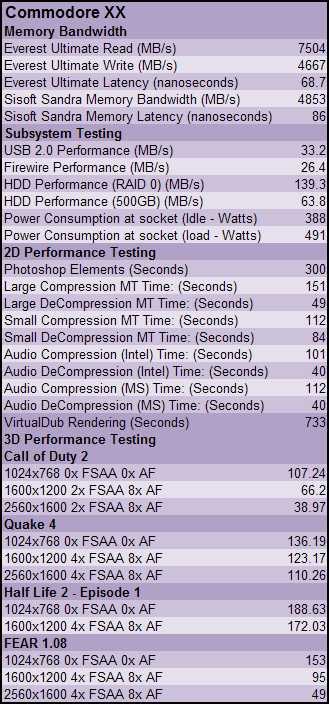
Test Setup

Test Results
We reviewed the Dell XPS 700 and Alienware 7500-P2 with Blu-Ray last year, but they ran with Windows XP and a dual core CPU. The Vadim Cephus C80 ran Windows Vista, but it used such early Nvidia drivers it's not worth a comparison, before we even consider the large price difference as well.To build a reference system to test against it would mean tailoring it with our own skill, to obtain a performance that is unrealistic of what companies usually sell. They need something that will run all day every day for the next few years, so as to avoid the cost of future support calls and possible RMA's.
As far as our stability test goes, it doesn't take into account a few years worth of dust and use that could affect how a PC works, which we would expect our readers to be conscious of with their own self built PCs.
 The core memory performance is pretty good, although we've seen better from motherboard reviews where we've really tweaked the subsystems. The RAID-0 performance is also very good, and even the 500GB Samsung hard drive performs the same as a 74GB Raptor we use in the labs.
The core memory performance is pretty good, although we've seen better from motherboard reviews where we've really tweaked the subsystems. The RAID-0 performance is also very good, and even the 500GB Samsung hard drive performs the same as a 74GB Raptor we use in the labs.As far as power consumption at the socket goes we actually expected far worse the under 500W. This means the 850W PSU is working between the 50-75% ideal area, but when loaded like this it still manages to kick out a lot of heat and noise.
In comparison, other PSUs like Corsair, Seasonic, Tagan, Enermax Infiniti and Gigabyte Odin are virtually silent at these output ranges. It also goes to show you don't need a massive PSU for a quad core CPU, three hard drives and a couple of 8800 GTXs either.
The combination of Windows Vista and Nvidia's drivers don't appear to do any favours for general performance compared to what we normally see. In all areas the PC comes out slower than a respective machine running XP, comparing any nForce 6-series motherboard review it will show this up.
The decompression testing is particularly bad, taking twice as long in most places. And we know it's not the raw performance of the hard drives, but we suspect it's due to the fact the RAID 0 is not using a dedicated controller and the drivers aren't yet up to much in Vista. This obviously isn't Commodore's fault, it offers the fastest (theoretical) performance available and you can still select a single disk option that should cure this particular issue.
It's certainly a capable system for the most part: it may not be as fast as you can get in certain areas, but it's definitely not slow. Commodore has been conscientious in putting together kit that seems to work well together, even if it isn't optimised and is limited by parts out of its control that are likely to improve in time.
Overclocking
We tried to tweak the system, enabling EPP and overclocking both the CPU and GPUs but didn't get very far. EPP was easy and instantly shot the memory to 1066MHz 5-5-5-15-2T, but as we've seen before in previous memory articles, it didn't give us a huge performance increase.Overclocking the CPU using either the multiplier adjustment or just a couple of extra MHz on the front side bus proved a fruitless effort and stability was easily lost. The extra heat generated by trying to increase the voltage to combat this didn't improve the situation either, since the temperatures just increased instead.
Even the GPUs wouldn't take a modest overclock of 600MHz/1000MHz, and would lock up and blue screen almost immediately when a 3D application was started. Obviously the case is running on the fringes of capacity, because throughout testing at stock speeds we didn't suffer from a single stability issue.

MSI MPG Velox 100R Chassis Review
October 14 2021 | 15:04








Want to comment? Please log in.